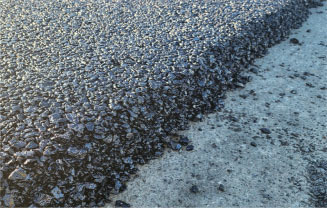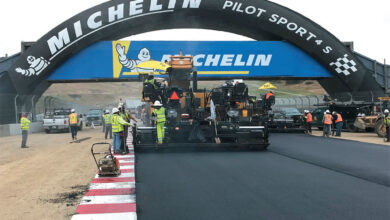Delaware’s Pervious Pavements Mitigate Roadway Flooding
CASE STUDY: SOUTH BOWERS ROAD
BY JIM PAPPAS, PE, DIRECTOR, TRANSPORTATION RESILIENCY & SUSTAINABILITY, DELAWARE DOT
As the lowest lying state in the nation, Delaware is all too familiar with the effects of climate change and sea level rise on our infrastructure. We see this daily as some roads have overtopping of water due to tide and wind cycles, regardless of storm events. Also known as ‘sunny day’ flooding events, they are becoming more frequent and widespread across the state’s roadway network, causing an ever-increasing amount of concern as some of these roadways provide the vital link to coastal communities that have only a single point of access.
As the transportation agency operating and maintaining the majority of the state’s infrastructure, the Delaware Department of Transportation (DelDOT) made resiliency and sustainability of infrastructure a core mission by creating a new Division of Transportation Resilience & Sustainability in May 2021. This new division is working across the state with various stakeholders on resiliency and sustainability projects as varied as electric vehicle infrastructure planning, living shorelines projects, and determining and mapping equity and environmental justice communities.
In the area of infrastructure resilience, the division has initiated several short-term projects to raise key roadways that provide access for coastal communities and a coastal corridor. These projects are using pervious asphalt pavements to raise the roadways and allow water to go through the pavements as the tides rise. One project location has been completed with another planned for the summer and multiple other locations in the planning and design phase to use the new federal PROTECT funding.
FINDING A SOLUTION FOR SOUTH BOWERS ROAD IN KENT COUNTY OUTSIDE OF MILFORD
The community of South Bowers is a small coastal community of 36 homes with about half of those being year-round residents. Based upon data collected by the University of Delaware, there are times that this roadway has over two feet of water, making the roadway unavailable to commuting residents. The condition has worsened over time, leading DelDOT to address the situation to provide access to residents and service providers such as the USPS and school buses.
Knowing the unique challenges of this coastal location, DelDOT initiated subsurface investigations to determine the underlying subgrade conditions and stability prior to determining a course of action. The concern with a simple dense graded hot-mix asphalt overlay was the weight; could the underlying soil support the additional weight of an overlay? Based upon the subsurface analysis, the underlying material was very soft and compressible, which would not provide the structural support of additional weight without significant settlement.
Given this additional information, DelDOT reached out to Dr. Jo Sias from the University of New Hampshire and Dr. Ben Bowers from Auburn University to review other pavement options. Based upon further discussions, the idea of using a pervious asphalt pavement was first conceived. Through follow-up conversations and some analysis, this was determined to be a viable option, though somewhat unconventional given most pervious pavements move water vertically. With the concept on South Bowers Road, the water would actually be allowed to move laterally across and through the pavement as the tide cycles rose and lowered. Based upon preliminary reviews and research, such as application of pervious pavement had not been attempted.
One unique challenge associated with this location and the possible use of pervious pavement was the concern about the pervious pavement clogging with debris. DelDOT wanted to design a system that was as maintenance-free as possible, deciding to use a geotextile stone wrap along the longitudinal outside pavement edge to act as a filter medium. Additionally, this geotextile stone wrap would act as a roadway safety edge drop off support for the overlay that was designed.
Now that we had a pavement section, we had to decide the depth of the overlay. DelDOT had worked with the University of Delaware to deploy logging devices along the roadway to determine depth of water at various times. Based upon the data collected, there were times when two feet of water covered the roadway. Given the layout of the area and the geometrics of the roadway, DelDOT knew a two-foot overlay was not possible. However, the question then became how thick of an overlay could be designed for the roadway width and wetland delineations close to the existing edge of pavement. We decided on a five-inch overlay as that was the maximum overlay that could be constructed to keep the minimum width of the roadway and not encroach upon the wetlands, while minimizing permitting requirements.
Once planning was completed, DelDOT worked with AECOM for the design package including a new item for the geotextile stone wrap for the longitudinal edge. After the design package was completed, DelDOT worked with Allan Myers on the construction aspects of the project including the cost estimate and schedule. Once all administrative details were completed, Allan Myers started the preparation work by installing the geotextile stone wrap first and then paving up against it. The project started in November 2022 but had to be delayed for a period due to supply chain issues in obtaining all the materials needed. The project was completed in December 2022 and is performing well. Follow-up field testing of the site is being discussed to include bond, permeability, settlement, and overall pavement performance.
APPLYING LEARNINGS ALONG THE COAST
Based upon this initial project, DelDOT is planning a second project on Woodland Beach Road this summer, another single-access roadway for a coastal community. This roadway has a wider footprint, including shoulders and guardrail, so a more conventional overlay is being planned without the need for the geotextile stone edge wrap. Furthermore, DelDOT has scoped several segment locations along the SR 9 coastal corridor running between New Castle and Little Creek for pervious asphalt pavement overlays to mitigate existing roadway flooding conditions. Each location has similar characteristics of roadway flooding and soft subgrade materials.
DelDOT is hopeful this overlay strategy is successful as a shortterm mitigation measure to allow access to these communities. With more than 250 miles designated as frequently flooded roadways across the state, there are many more miles requiring mitigation action to ensure mobility across the state.







